ECU GEELY CK 2008 Workshop Manual
[x] Cancel search | Manufacturer: GEELY, Model Year: 2008, Model line: CK, Model: GEELY CK 2008Pages: 392, PDF Size: 38.86 MB
Page 11 of 392

4Table 3
CO HC Problems Causes
1. Fa ult
. Inc orre c t ignition timing
. Fouled, shorted or imprope rly cle aranc e of spa rk plug
2. Incorrect valve clearance
3. Le a ky inta ke & e xha ust valve s
4. Leaky cylinders
1. Air leaks
. PCV hoses, intake manifold
. Throttle body
. Brake booster circuit
2. Le a n mixture ga s c a using misfire
1. Clogged air filter
2. Clogge d P CV valve
. Faulty ECU
. Fa ulty fue l pre ssure regula tor
. Faulty water temperature sensor
. Faulty air compressor
. Faulty injectors
. Faulty throttle position sensor Normal
Low High
High HighRough idle
(Black smoke
from exhaust
pipe ) Rough idle Rough idle High
Page 48 of 392
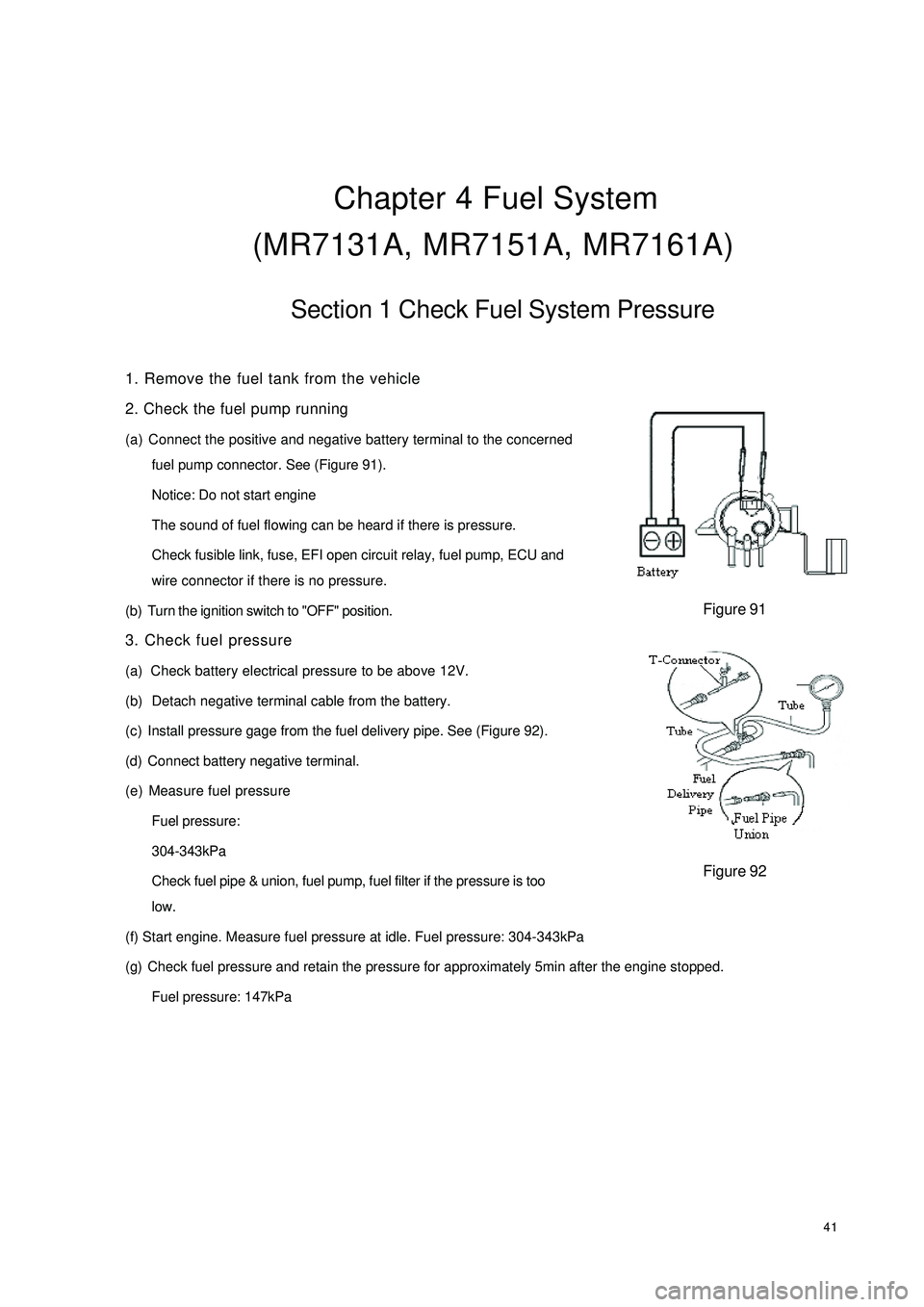
41Chapter 4 Fuel System
(MR7131A, MR7151A, MR7161A)Section 1 Check Fuel System Pressure1. Remove the fuel tank from the vehicle
2. Check the fuel pump running
(a) Connect the positive and negative battery terminal to the concerned
fuel pump connector. See (Figure 91).
Notice: Do not start engine
The sound of fuel flowing can be heard if there is pressure.
Check fusible link, fuse, EFI open circuit relay, fuel pump, ECU and
wire connector if there is no pressure.
(b) Turn the ignition switch to "OFF" position.
3. Check fuel pressure
(a) Check battery electrical pressure to be above 12V.
(b) Detach negative terminal cable from the battery.
(c) Install pressure gage from the fuel delivery pipe. See (Figure 92).
(d) Connect battery negative terminal.
(e) Measure fuel pressure
Fuel pressure:
304-343kPa
Check fuel pipe & union, fuel pump, fuel filter if the pressure is too
low.
(f) Start engine. Measure fuel pressure at idle. Fuel pressure: 304-343kPa
(g) Check fuel pressure and retain the pressure for approximately 5min after the engine stopped.
Fuel pressure: 147kPaFigure 91Figure 92
Page 71 of 392
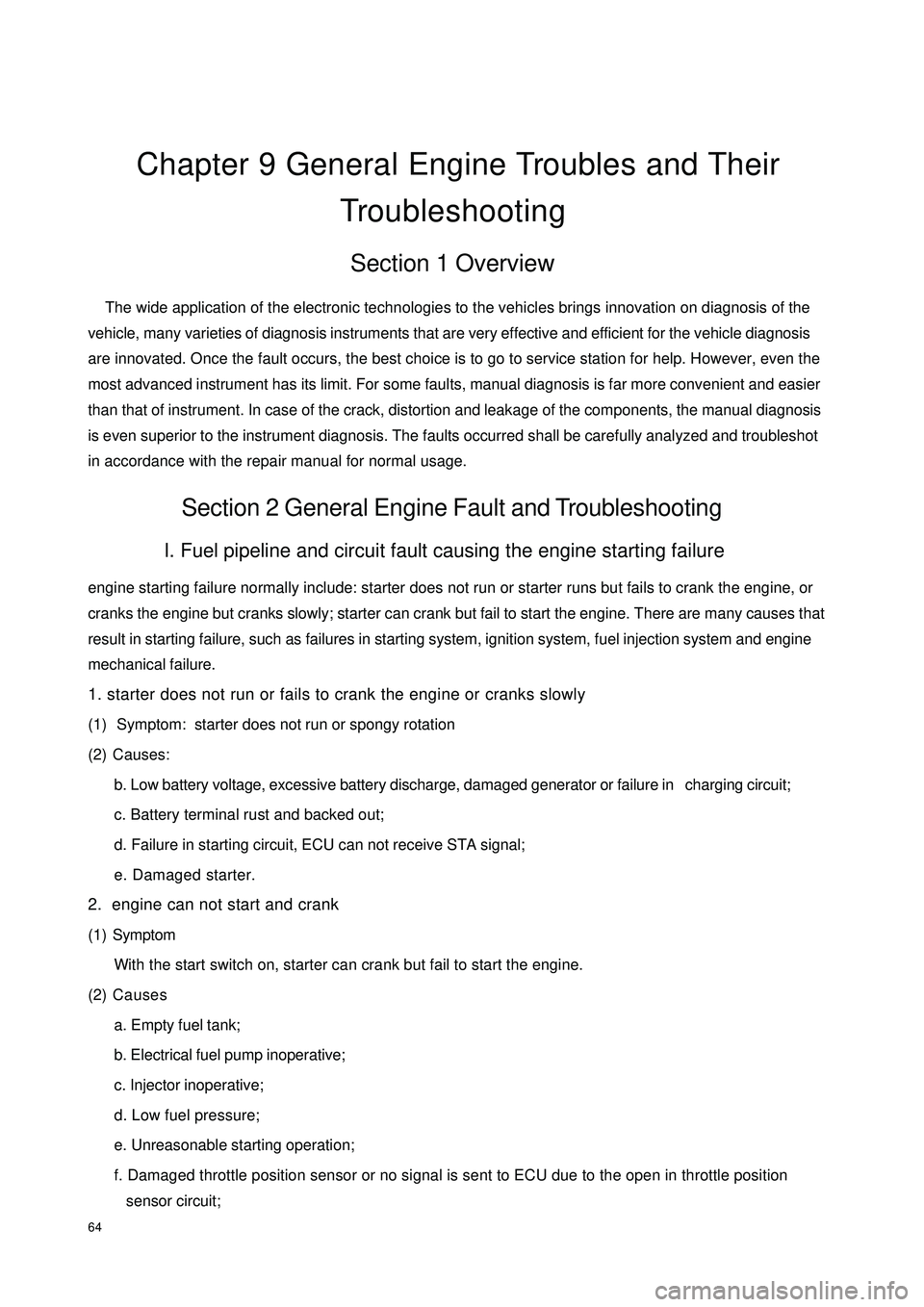
64Chapter 9 General Engine Troubles and Their
TroubleshootingSection 1 Overview The wide application of the electronic technologies to the vehicles brings innovation on diagnosis of the
vehicle, many varieties of diagnosis instruments that are very effective and efficient for the vehicle diagnosis
are innovated. Once the fault occurs, the best choice is to go to service station for help. However, even the
most advanced instrument has its limit. For some faults, manual diagnosis is far more convenient and easier
than that of instrument. In case of the crack, distortion and leakage of the components, the manual diagnosis
is even superior to the instrument diagnosis. The faults occurred shall be carefully analyzed and troubleshot
in accordance with the repair manual for normal usage.Section 2 General Engine Fault and TroubleshootingI. Fuel pipeline and circuit fault causing the engine starting failureengine starting failure normally include: starter does not run or starter runs but fails to crank the engine, or
cranks the engine but cranks slowly; starter can crank but fail to start the engine. There are many causes that
result in starting failure, such as failures in starting system, ignition system, fuel injection system and engine
mechanical failure.
1. starter does not run or fails to crank the engine or cranks slowly
(1) Symptom: starter does not run or spongy rotation
(2) Causes:
b. Low battery voltage, excessive battery discharge, damaged generator or failure in charging circuit;
c. Battery terminal rust and backed out;
d. Failure in starting circuit, ECU can not receive STA signal;
e. Damaged starter.
2. engine can not start and crank
(1) Symptom
With the start switch on, starter can crank but fail to start the engine.
(2) Causes
a. Empty fuel tank;
b. Electrical fuel pump inoperative;
c. Injector inoperative;
d. Low fuel pressure;
e. Unreasonable starting operation;
f. Damaged throttle position sensor or no signal is sent to ECU due to the open in throttle position
sensor circuit;
Page 72 of 392
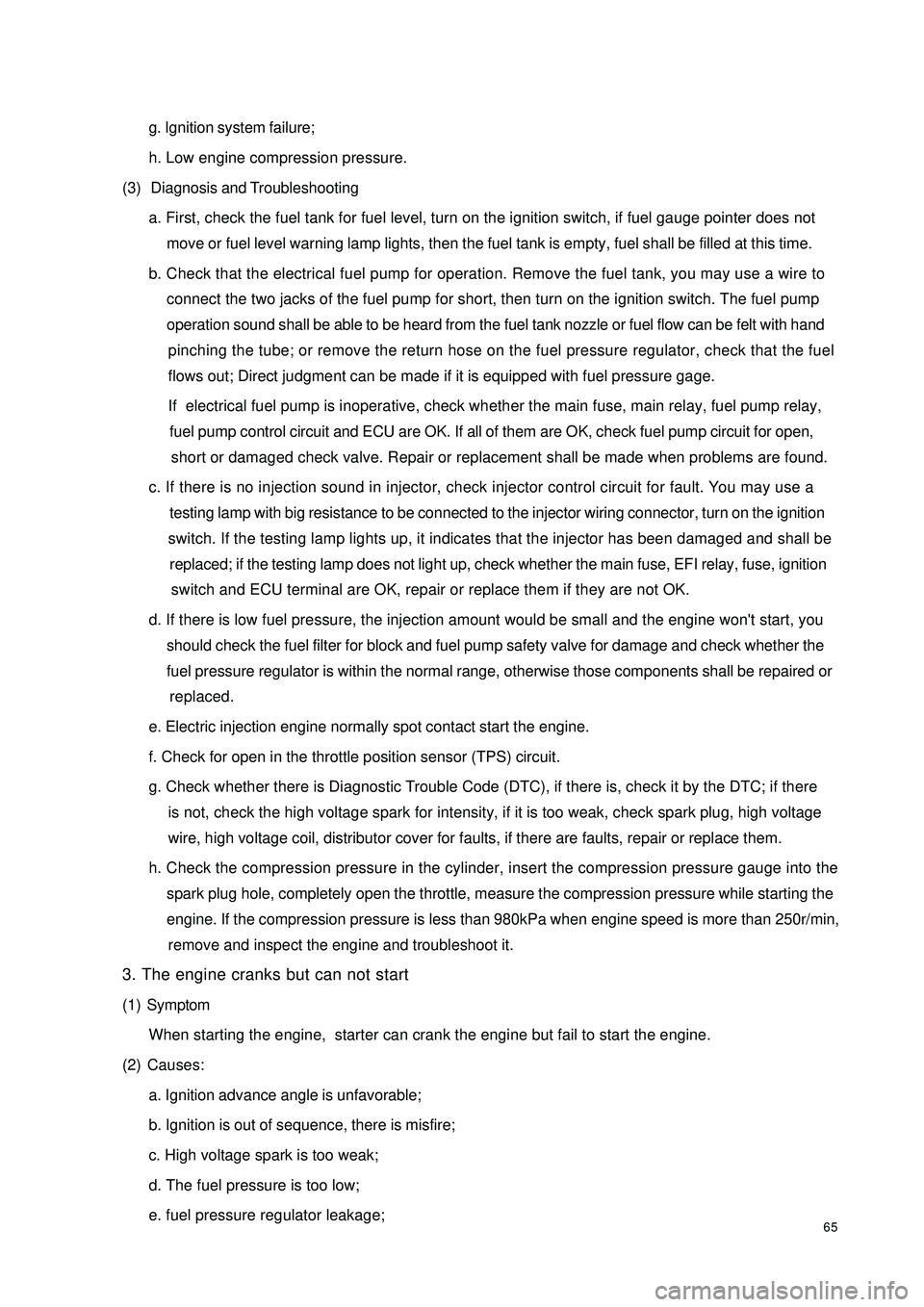
65g. Ignition system failure;
h. Low engine compression pressure.
(3) Diagnosis and Troubleshooting
a. First, check the fuel tank for fuel level, turn on the ignition switch, if fuel gauge pointer does not
move or fuel level warning lamp lights, then the fuel tank is empty, fuel shall be filled at this time.
b. Check that the electrical fuel pump for operation. Remove the fuel tank, you may use a wire to
connect the two jacks of the fuel pump for short, then turn on the ignition switch. The fuel pump
operation sound shall be able to be heard from the fuel tank nozzle or fuel flow can be felt with hand
pinching the tube; or remove the return hose on the fuel pressure regulator, check that the fuel
flows out; Direct judgment can be made if it is equipped with fuel pressure gage.
If electrical fuel pump is inoperative, check whether the main fuse, main relay, fuel pump relay,
fuel pump control circuit and ECU are OK. If all of them are OK, check fuel pump circuit for open,
short or damaged check valve. Repair or replacement shall be made when problems are found.
c. If there is no injection sound in injector, check injector control circuit for fault. You may use a
testing lamp with big resistance to be connected to the injector wiring connector, turn on the ignition
switch. If the testing lamp lights up, it indicates that the injector has been damaged and shall be
replaced; if the testing lamp does not light up, check whether the main fuse, EFI relay, fuse, ignition
switch and ECU terminal are OK, repair or replace them if they are not OK.
d. If there is low fuel pressure, the injection amount would be small and the engine won't start, you
should check the fuel filter for block and fuel pump safety valve for damage and check whether the
fuel pressure regulator is within the normal range, otherwise those components shall be repaired or
replaced.
e. Electric injection engine normally spot contact start the engine.
f. Check for open in the throttle position sensor (TPS) circuit.
g. Check whether there is Diagnostic Trouble Code (DTC), if there is, check it by the DTC; if there
is not, check the high voltage spark for intensity, if it is too weak, check spark plug, high voltage
wire, high voltage coil, distributor cover for faults, if there are faults, repair or replace them.
h. Check the compression pressure in the cylinder, insert the compression pressure gauge into the
spark plug hole, completely open the throttle, measure the compression pressure while starting the
engine. If the compression pressure is less than 980kPa when engine speed is more than 250r/min,
remove and inspect the engine and troubleshoot it.
3. The engine cranks but can not start
(1) Symptom
When starting the engine, starter can crank the engine but fail to start the engine.
(2) Causes:
a. Ignition advance angle is unfavorable;
b. Ignition is out of sequence, there is misfire;
c. High voltage spark is too weak;
d. The fuel pressure is too low;
e. fuel pressure regulator leakage;
Page 74 of 392
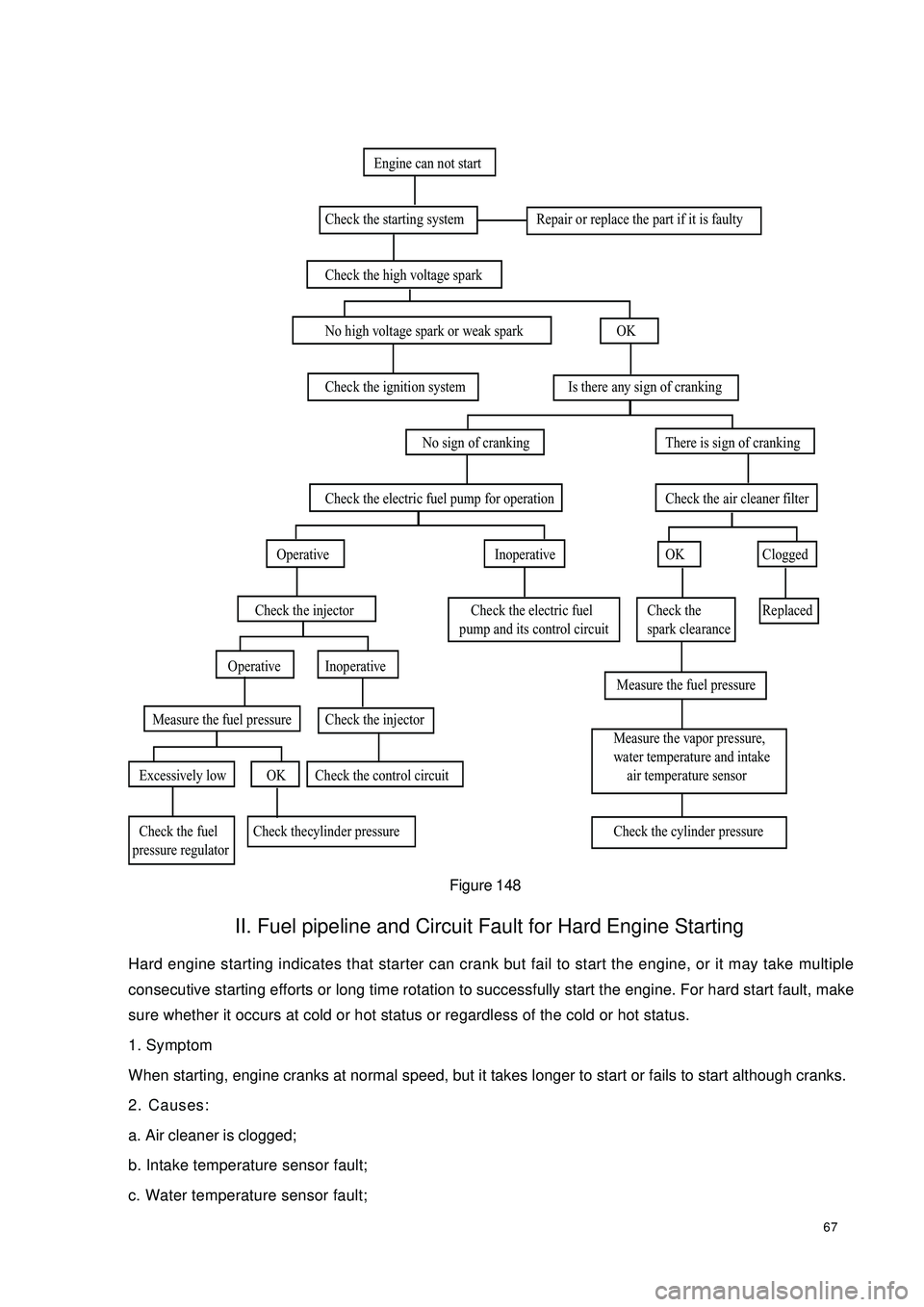
67Figure 148II. Fuel pipeline and Circuit Fault for Hard Engine StartingHard engine starting indicates that starter can crank but fail to start the engine, or it may take multiple
consecutive starting efforts or long time rotation to successfully start the engine. For hard start fault, make
sure whether it occurs at cold or hot status or regardless of the cold or hot status.
1. Symptom
When starting, engine cranks at normal speed, but it takes longer to start or fails to start although cranks.
2. Causes:
a. Air cleaner is clogged;
b. Intake temperature sensor fault;
c. Water temperature sensor fault; Engine can not start
Check the starting system Repair or replace the part if it is faulty
Check the high voltage spark
No high voltage spark or weak spark OK
Check the ignition system Is there any sign of cranking
No sign of cranking There is sign of cranking
Check the electric fuel pump for operation Check the air cleaner filter
Operative Inoperative OK Clogged
Check the injector Check the electric fuel Check the Replaced
pump and its control circuit spark clearance
Operative Inoperative
Measure the fuel pressure
Measure the fuel pressure Check the injector
Measure the vapor pressure,
water temperature and intake
Excessively low OK Check the control circuit air temperature sensor
Check the fuel Check thecylinder pressure Check the cylinder pressure
pressure regulator
Page 76 of 392

69j. Poor intake and exhaust valve seal, failed piston ring, low compression pressure;
h. Too many carbon deposit in spark plug and combustion chamber;
k. Water temperature switch and thermostat fault;
l. Aging of Oxygon sensor;
m. Incorrect ignition timing;
n. Check valve fault.
Figure 149Engine is difficult to start
Check whether the air cleaner is clogged Clogged
Troubleshooting
OK
Check the idle control valve NG
Repair or replace
OK
Check the fuel pressure Excessivly low
Service the electric fuel pump,
fuel filter and fuel pressure regulator
OK
Check the vacuum pressure sensor NG
Replace
OK
Check the water temperature sensor and intake air temperature sensor NG
Replace
OK
Check the start switch signal No
Service the start signal wire
OK
Check the ignition timing Misaligned
Adjust
OK
Check the cylinder pressure NG
Disassemble the engine
OK
Replace the ECU to retry
Page 77 of 392
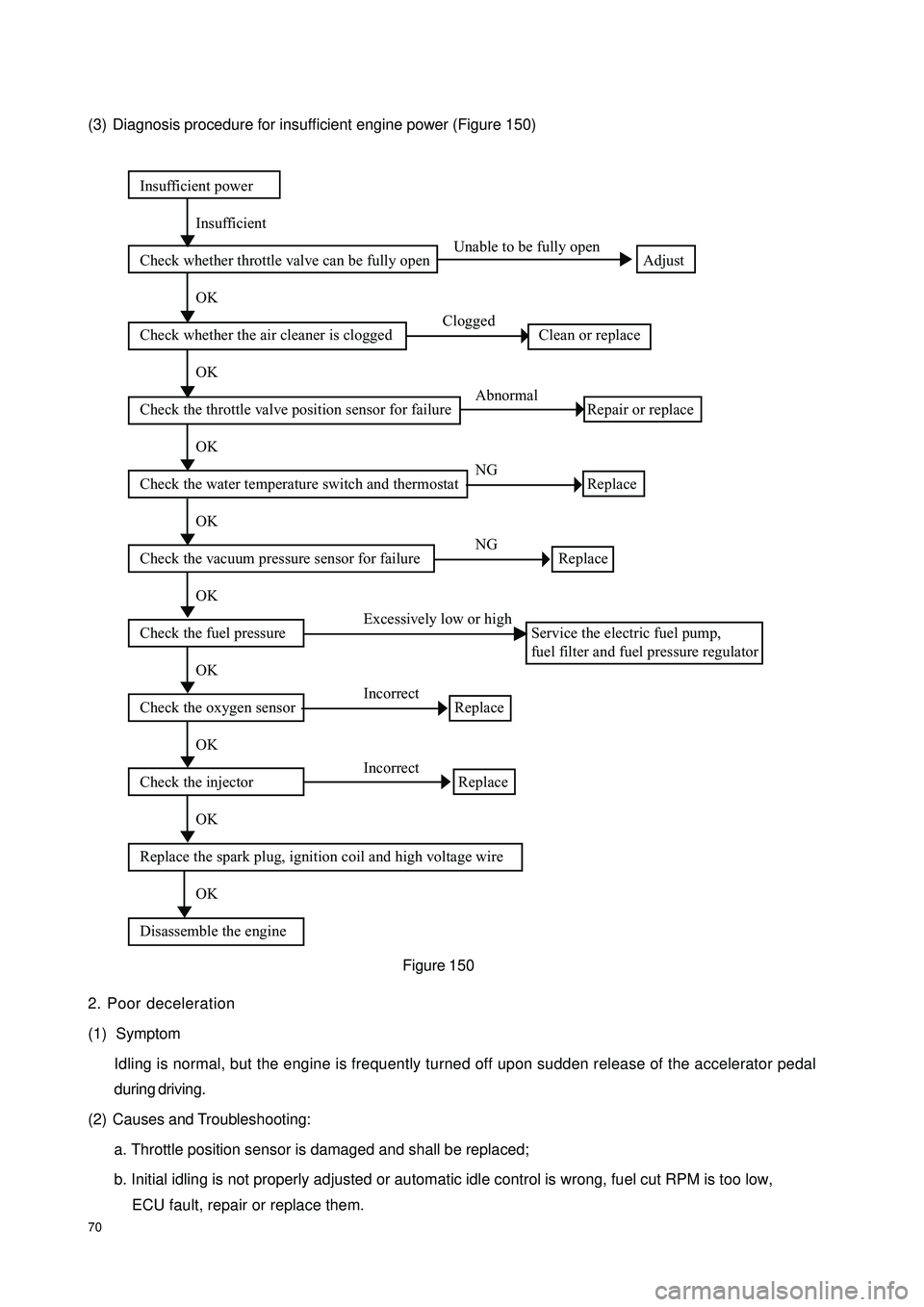
70(3) Diagnosis procedure for insufficient engine power (Figure 150)
2. Poor deceleration
(1) Symptom
Idling is normal, but the engine is frequently turned off upon sudden release of the accelerator pedal
during driving.
(2) Causes and Troubleshooting:
a. Throttle position sensor is damaged and shall be replaced;
b. Initial idling is not properly adjusted or automatic idle control is wrong, fuel cut RPM is too low,
ECU fault, repair or replace them.Insufficient power
Insufficient
Check whether throttle valve can be fully open Unable to be fully open
Adjust
OK
Check whether the air cleaner is clogged Clogged
Clean or replace
OK
Check the throttle valve position sensor for failure Abnormal
Repair or replace
OK
Check the water temperature switch and thermostat NG
Replace
OK
Check the vacuum pressure sensor for failure NG
Replace
OK
Check the fuel pressure Excessively low or high
Service the electric fuel pump,
fuel filter and fuel pressure regulator
OK
Check the oxygen sensor Incorrect
Replace
OK
Check the injector Incorrect
Replace
OK
Replace the spark plug, ignition coil and high voltage wire
OK
Disassemble the engineFigure 150
Page 78 of 392
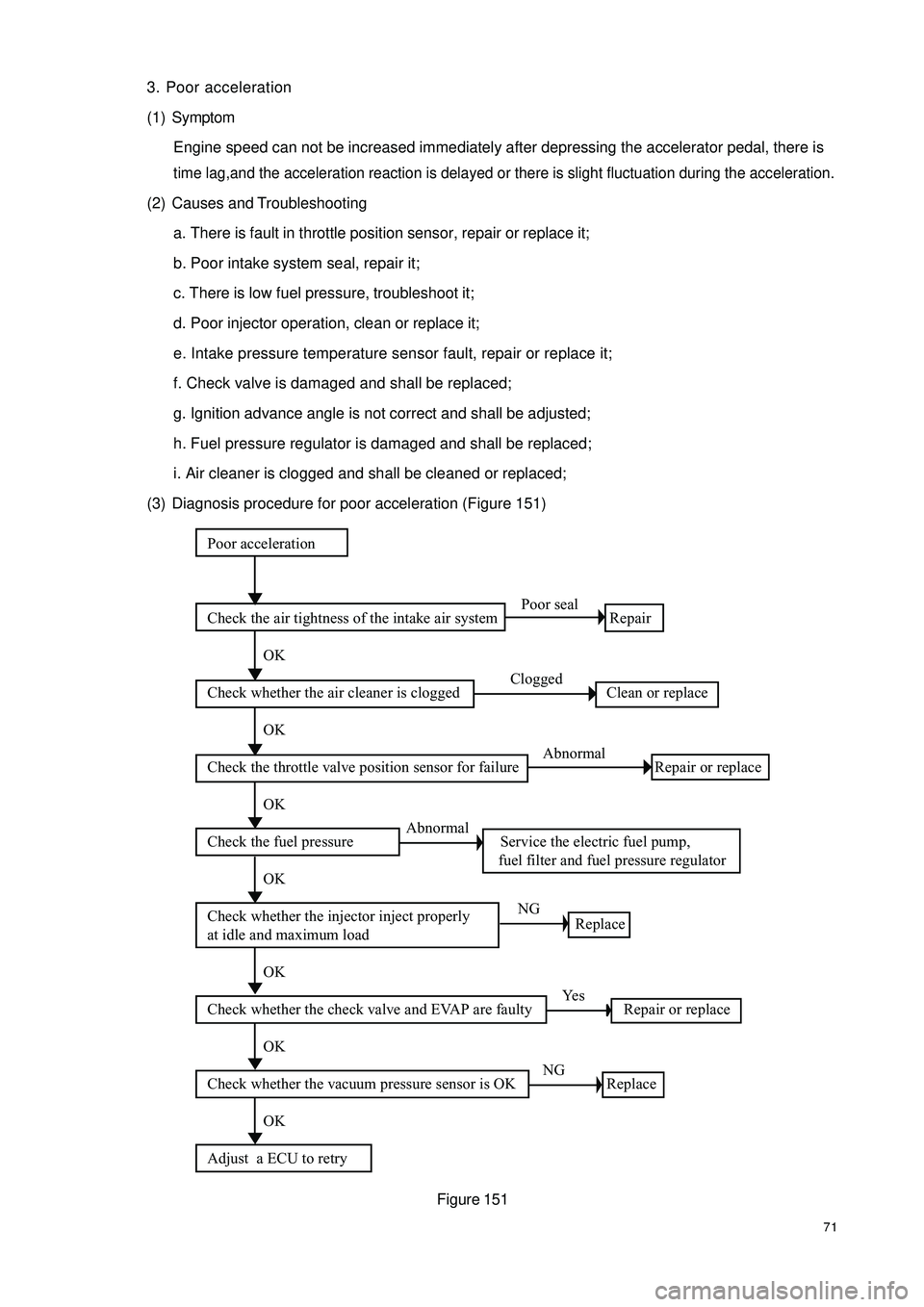
713. Poor acceleration
(1) Symptom
Engine speed can not be increased immediately after depressing the accelerator pedal, there is time lag,and the acceleration reaction is delayed or there is slight fluctuation during the acceleration.(2) Causes and Troubleshooting
a. There is fault in throttle position sensor, repair or replace it;
b. Poor intake system seal, repair it;
c. There is low fuel pressure, troubleshoot it;
d. Poor injector operation, clean or replace it;
e. Intake pressure temperature sensor fault, repair or replace it;
f. Check valve is damaged and shall be replaced;
g. Ignition advance angle is not correct and shall be adjusted;
h. Fuel pressure regulator is damaged and shall be replaced;
i. Air cleaner is clogged and shall be cleaned or replaced;
(3) Diagnosis procedure for poor acceleration (Figure 151)
Figure 151Poor acceleration
Check the air tightness of the intake air system Poor seal
Repair
OK
Check whether the air cleaner is clogged Clogged
Clean or replace
OK
Check the throttle valve position sensor for failure Abnormal
Repair or replace
OK
Check the fuel pressure Abnormal
Service the electric fuel pump,
fuel filter and fuel pressure regulator
OK
Check whether the injector inject properly
at idle and maximum load NG
Replace
OK
Check whether the check valve and EVAP are faulty Yes
Repair or replace
OK
Check whether the vacuum pressure sensor is OK NG
Replace
OK
Adjust a ECU to retry
Page 83 of 392

7611. General engine fault symptom and faulty area (Table 7)
Table 7
Unable to explode initially
Unable to explode completely
Difficult for cold start
Difficult for hot start
No fast ilde
Low idle speed
High idle speed
Rough ildling
Idle hunting
At urgent acceleration
When the accelerator pedal is releasec
During idling
Poor acceleration
Hunting during driving
Insufficient power
KnockInta ke a bosolute pre ssure
se nsor
�c�c�c�c�c�c�c �c�c
Water temperature sensor�c�c�c�c �c�c �c �c�c �c
Re volution spee d se nsor
�c
Throttle valve position
se nsor
�c�c�c �c�c�c�c�c
Vehicle speed sensor
�c
Fuel pump system
�c�c �c �c�c �c
Fue l pre ssure regulator
�c�c�c�c�c �c �c�c�c�c
Fue l filte r a nd pipe line
�c�c �c �c�c�c�c
Injector
�c�c�c�c�c �c �c�c�c
Sta rte r signal
�c�c
Ignition c oil
�c�c�c
Spark plug
�c�c�c�c �c �c�c �c
High pre ssure ca ble
�c�c
Ignition timing
�c�c �c �c �c �c�c
Igniter in the ECU
�c �c�c�c
Throttle valve
�c�c�c�c �c
Throttle valve body�c�c �c
Air leakage in the intake
air system�c�c �c�c�c�c�c �c
Air valve
�c�c�c�c�c
ECU powe r supply circuit
�c
Ignition swtich
�c
Ma in re la y
�c
Fuel pump re lay�cPoor driving Difficult to start Poor idling Engine off
Power
supply
system Control
system
Fuel
system
Ignitio n
system
Intake
air
systemSuspect
AreaSymptom
Page 84 of 392
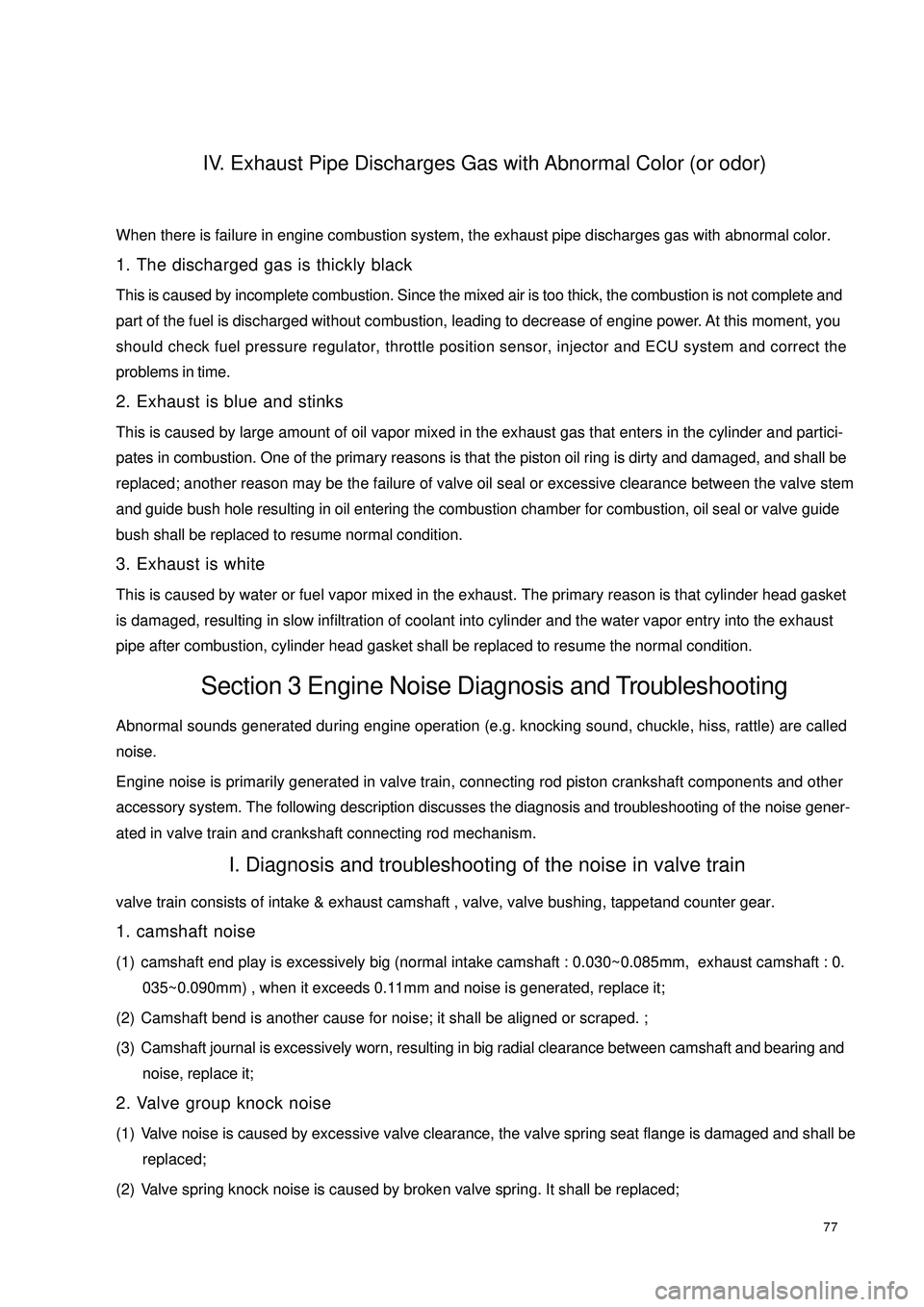
77IV. Exhaust Pipe Discharges Gas with Abnormal Color (or odor)When there is failure in engine combustion system, the exhaust pipe discharges gas with abnormal color.
1. The discharged gas is thickly black
This is caused by incomplete combustion. Since the mixed air is too thick, the combustion is not complete and
part of the fuel is discharged without combustion, leading to decrease of engine power. At this moment, you
should check fuel pressure regulator, throttle position sensor, injector and ECU system and correct the
problems in time.
2. Exhaust is blue and stinks
This is caused by large amount of oil vapor mixed in the exhaust gas that enters in the cylinder and partici-
pates in combustion. One of the primary reasons is that the piston oil ring is dirty and damaged, and shall be
replaced; another reason may be the failure of valve oil seal or excessive clearance between the valve stem
and guide bush hole resulting in oil entering the combustion chamber for combustion, oil seal or valve guide
bush shall be replaced to resume normal condition.
3. Exhaust is white
This is caused by water or fuel vapor mixed in the exhaust. The primary reason is that cylinder head gasket
is damaged, resulting in slow infiltration of coolant into cylinder and the water vapor entry into the exhaust
pipe after combustion, cylinder head gasket shall be replaced to resume the normal condition.Section 3 Engine Noise Diagnosis and TroubleshootingAbnormal sounds generated during engine operation (e.g. knocking sound, chuckle, hiss, rattle) are called
noise.
Engine noise is primarily generated in valve train, connecting rod piston crankshaft components and other
accessory system. The following description discusses the diagnosis and troubleshooting of the noise gener-
ated in valve train and crankshaft connecting rod mechanism.I. Diagnosis and troubleshooting of the noise in valve trainvalve train consists of intake & exhaust camshaft , valve, valve bushing, tappetand counter gear.
1. camshaft noise
(1) camshaft end play is excessively big (normal intake camshaft : 0.030~0.085mm, exhaust camshaft : 0.
035~0.090mm) , when it exceeds 0.11mm and noise is generated, replace it;
(2) Camshaft bend is another cause for noise; it shall be aligned or scraped. ;
(3) Camshaft journal is excessively worn, resulting in big radial clearance between camshaft and bearing and
noise, replace it;
2. Valve group knock noise
(1) Valve noise is caused by excessive valve clearance, the valve spring seat flange is damaged and shall be
replaced;
(2) Valve spring knock noise is caused by broken valve spring. It shall be replaced;